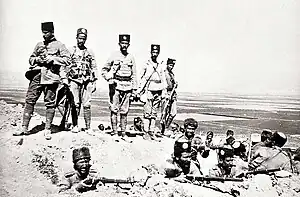| Swedish intervention in Persia | ||||||||
|---|---|---|---|---|---|---|---|---|
| Part of the Persian campaign | ||||||||
 | ||||||||
| ||||||||
| Belligerents | ||||||||
|
Swedish volunteers (1916–1921) | Insurgents |
| ||||||
| Strength | ||||||||
|
| Several clans and villages |
| ||||||
| Casualties and losses | ||||||||
|
| Unknown |
| ||||||
The Swedish intervention in Persia was a small-scale military operation between 1911 and 1916. The goal was to quell regional uprisings and modernize the Persian army, but as a result of pressure from Russia and United Kingdom, Sweden decided to call back most of their officers during World War I.
Background
Persia was rather unstable in the early 1900s, making the roads difficult to traverse due to frequent raiding by insurgents. Because of this (and fearring British intervention), the Persian government searched for a neutral power that could help modernize and create a gendarmerie able to fight off the insurgents.[5] Sweden was best suited for the job and in 1911, and the first military officers arrived under general Harald Hjalmarson.[6]
1911–1914

The gendarmes were put in charge of patrolling around 1,700 kilometers of road and steadily grew in number.[7] They had several run-ins with clan members and insurgents and scored many victories, even killing a local chieftain.[1] The bloodiest battles occurred in Kazerun in 1914 when several gendarmes died fighting under Josef Pousette (who had been injured fighting against insurgents in Tehran).[7][6][8] The Swedes also conducted several expeditions throughout Persia, such as the Boroudjerd expedition and the Chiraz expedition. Even though the battles were bloody and Swedish officers were at serious risk in Persia, many decided to join the gendarmes attracted by better pay and opportunities than in Sweden.
1914–1916

The United Kingdom and Russia decided to invade Persia in 1914 at the outbreak of World War I. The opinions of the Swedes reflected those popular back home, namely that they were pro-German. The Swedish officers decided to help the Persians and engaged in numerous battles with the Allies, including the Kermanshah operation, Battle of Qom, British occupation of Bushehr and Battle Robat Karim. In 1915 the Russians and British therefore pressured Sweden to call back their officers. The Swedish government complied and the number of Swedes present in Persia decreased until there were none remaining in 1916. However, the hostilities with the Allies did not hamper the fight against the insurgents. Several Swedes and Persians died in combat with the insurgents between 1914 and 1916 in conflicts such as th Battle of Bouin and that of Kazvin when the gendarmes captured 8,000 sheep.[1][2] The gendarmes also persecuted and captured all clan members of Abba Khan (who was shot by Boris Möller).[1]
1916–1921
Five Swedes decided to stay on, serving as volunteers after 1916, though under German leadership. The leadership of the Persian Gendarmerie continued to be Swedish until 1921.
See also
References
- 1 2 3 4 Ericson Wolke, Lars (4 June 2021). "Svenskar stred i persiska gendarmeriet" [Swedes fought in the Persian gendarmerie]. Populär historia (in Swedish). Lund: Historiska media (2). SELIBR 8264634.
{{cite journal}}: CS1 maint: date and year (link) - 1 2 3 Karlsson, Sandra (2006-05-21), Svenska män i solens och lejonets land – en fallstudie av svensk orientalism i Persien 1911-1925 [Swedish men in the land of the sun and the lion – a case study of Swedish orientalism in Persia 1911-1925] (PDF) (in Swedish), Södertörn University, retrieved 12 January 2024
- ↑ "Statistics of the Military Effort of the British Empire" (London: HMSO, 1920). Page 777. 2,050 British Army and 49,198 British Indian Army personnel sent to the "Persian Gulf Theatre" from India in total.
- ↑ Volkov, Denis V. (2022). "Bringing democracy into Iran: a Russian project for the separation of Azerbaijan". Middle Eastern Studies. 58 (6): 4. doi:10.1080/00263206.2022.2029423. S2CID 246923610.
The Russian military force, occupying not only Azerbaijan but the entire north and north-east of Iran, eventually amounted to almost twenty thousand by the outbreak of the First World War. After the opening of the so-called Persidskii front [the Persian front], which became the south flank of the First World War theatre, this number gradually grew to eighty or ninety thousand.
- ↑ "The Swedish-led Gendarmerie in Persia 1911-1916 State Building and Internal Colonization".
- 1 2 "Welcome to Encyclopaedia Iranica".
- 1 2 "Farmors kusin stred i Persien". 23 October 2020.
- ↑ https://web.archive.org/web/20170831160456/http://www.ashkdahlen.com/index.php?id=126